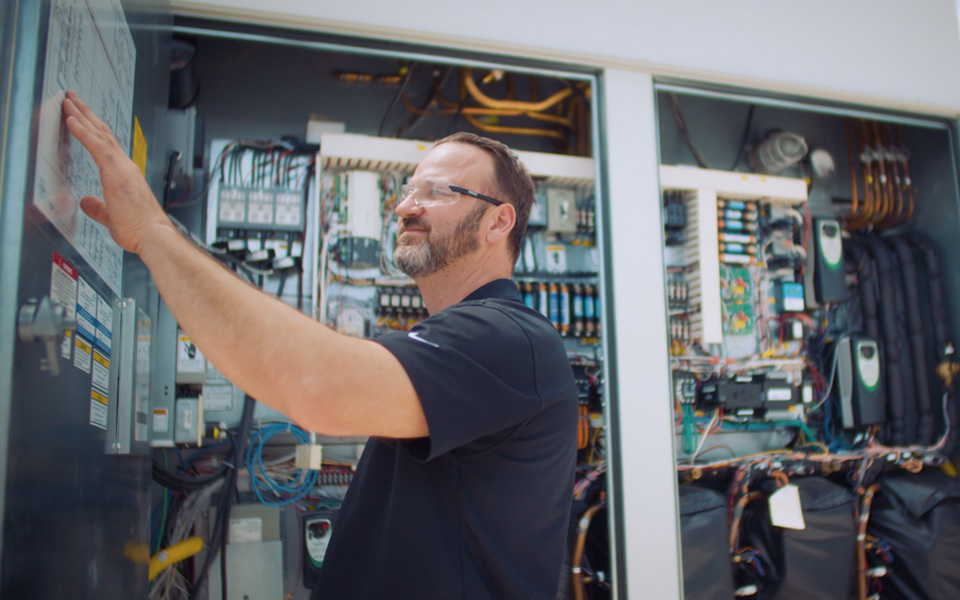*On June 1, 2023 Emerson’s Climate Technologies business became a new standalone company – Copeland. Though our name has changed, we are building on more than a century of HVACR innovation and industry leadership, and Copeland continues to offer the same products, industry stewardship, and learning opportunities you’ve grown to trust. Information found on this webpage posted before June 1, 2023 may contain our old name or branding, but you can be at ease knowing it was created with the knowledge and expertise of Copeland.
For years, the HVACR industry has braced itself for the upcoming skills gap and lack of skilled technicians coming down the pipeline. According to recent estimates, 80,000 HVACR technician jobs are currently unfilled — representing 39% of the total HVACR industry workforce. Over the past two years, our industry has been plagued by supply chain issues and material shortages, but the “human” shortage is arguably one of the biggest issues our industry faces today.

HVACR professionals serve many essential functions in modern life: providing comfort cooling and maintaining the integrity of the cold chain responsible for preserving food and life-saving medicines. A career in HVACR offers innumerous opportunities for advancement, as well as entry-level salaries that exceed that of many careers associated with a four-year college degree. Unfortunately, like most other trades, these jobs have been stigmatized for years as being “dirty,” “low-paying” or “low-tech.” With so many technical advancements within the industry, HVACR has come a long way to break away from these stereotypes, but recruiting challenges remain. Copeland assembled a global panel of expert technicians, practitioners and apprentices to explore ideas for how we can reverse the trend and step up our global recruiting efforts. Below are some of the major takeaways.
HVACR Recruiting Must Start at an Earlier Age
Copeland industry experts discussed the urgency with which our industry must recruit the next generation of HVACR technicians to replace the growing number of retiring professionals and fill the upcoming skills gap. It was noted during the discussion that baby boomers are retiring, and there simply aren’t enough students or new job seekers to replace them.
Those participating on the panel urged industry stakeholders to start recruitment efforts early in high school by educating students about the expanding opportunities within the HVACR profession. One participant commented: “Everyone knows what a nurse does or what a physical therapist does. But what does an HVACR technician do? We need to get in front of students early and entice them — show them the thermodynamics of refrigeration and how it keeps ice cream cold and relates to their lives.”
During the discussion, panel members reiterated the importance of apprenticeships and how federal, state and local efforts can supplement these efforts, stressing that a combination of classwork learning and on-the-job training can enable students to start getting paid while working toward a certification.
According to the panel, since 1937, the National Apprenticeship Act has supported the trade professions. The United States recently passed the Apprenticeship Act of 2021, which includes a $400 million fiscal allowance for supporting businesses and helping apprentices to work, learn and get paid in the process.
For students who participate in apprenticeship programs, panel members noted that they have a unique opportunity to earn while they learn and essentially start making a competitive wage in school. They pointed out that apprenticeships allow students to get paid as they are attending a vocational school or technical college while working toward their certification. Many are already earning what a college graduate makes right out of high school.
Learn from Current Apprentices
One of the best ways to understand how to recruit the next generation of HVACR technicians is to learn from young, up–and-coming tradespeople still in high school. That’s why Copeland’s panel included the perspective of Nicholas Didier, a future HVACR technician and vocational school student who participated in a pre-apprenticeship program at Copeland’s The Helix Innovation Center. Didier shared his motivation for pursuing an apprenticeship and how the experience set him on a path to success. Upon entering the program, his goals were to understand the basics of refrigeration and get hands-on HVACR field training.
“I knew I wanted to be an HVACR technician, and the opportunity at The Helix would help me on that path. But after being exposed to new technologies like CO2 chillers and other commercial refrigeration applications, I came out thinking more like an engineer,” said Didier.
As a rising star in the field, Didier earned a $1,000 scholarship from the Today’s Opportunities Offering Lifetime Skills (TOOLS) program and a new Ford Ranger truck. He was also recognized via a “20 Under 20” award in his residence’s county, which has awarded students enrolled in work-based learning programs.
“HVACR has already brought me many places, taught me many things, and allowed me to meet great people,” he said. Didier plans on pursuing advanced educational opportunities in the future to help build on his knowledge and further his career in HVACR.
Promote HVACR as an Evergreen Alternative Career Path
Copeland’s pre-apprenticeship programs are just one way we are helping to promote HVACR careers and solve the technician shortage. Filling the need for skilled technicians will not only require outreach to vocational schools and technical colleges, but also parents, local officials and other community members. Plus, it demands persistent engagement of potential students in apprenticeship opportunities and allowing them to earn a paycheck while they learn the trade.
HVACR careers present evergreen opportunities for students seeking long-term career growth and a viable alternative to a four-year college education. The anecdotes and individual perspectives of this global panel only scratched the surface of the emerging and exciting opportunities that await those who enter this career path.
Click here to learn more insights from Copeland’s Global HVACR Technician Roundtable.

8 proven strategies for rigorous cold chain management
Preparing for the approval and safe use of A2Ls in commercial refrigeration applications...
Protection for high-value shipments just got even better
We’re excited to announce the release of Copeland’s newest real-time tracker, the GO Real-Time...

Three proven strategies to prevent cargo theft
The over-the-road (OTR) transport industry is experiencing a surge in cargo thefts. As thieves...
